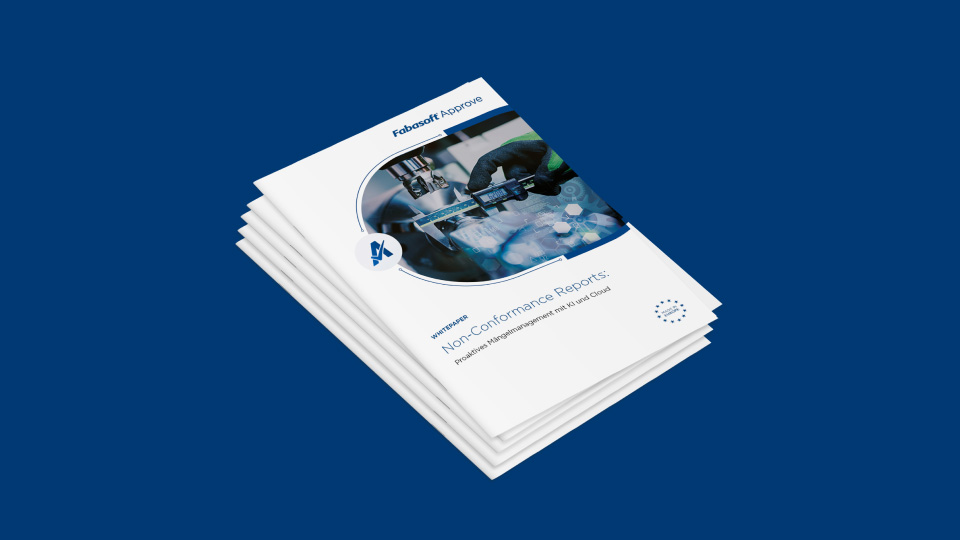Today, the integration of artificial intelligence plays a decisive role in optimizing quality management and preventive error avoidance, especially in combination with smart cloud technologies. By using supporting AI in the background, computer-aided quality (CAQ) systems can take their performance to a whole new level.
Requirements for AI in quality management
Integrating such a high-performance entity as artificial intelligence into your own company calls for a flexible and scalable digital data environment. The first step entails comprehensive digitalization. It is important here to break down historically grown data silos in order to create an ideal data basis for the application of AI functions.
Ideally, the AI database should include both internal company data as well as data from the supply chain. In order to avoid so-called "hallucinations" of the AI (i.e. incorrect answers due to a lack of context), it is important that the AI also specifies the corresponding data source for each answer. The knowledge memory of an AI is initially empty and must be built up by analyzing existing quality documents and training with customer-specific data.
Cloud technology as the basis for CAQ
Production companies that have already set up their data and document management system (DMS) on a cloud-native basis have structural advantages. The use of software as a service from a European, certified software provider enables simple and holistic processing of quality issues. As a "single source of truth", the DMS ideally combines the entire organizational knowledge and all business processes along the supply chain in a common data environment.
Expanding this information base with AI for data evaluation creates a powerful, cross-plant CAQ system that is able to react quickly to changes along the supply chain. In addition, it facilitates innovation compared to outdated on-premises systems.
Workflows without media discontinuity
This means that not only those involved within the plant have access to the relevant information, but external players (such as suppliers or customers) are also seamlessly integrated into the quality processes. A network of roles and access rights set up in the background ensures that the right people can see and edit the desired content. A powerful workflow engine links all processing staff and distributes tasks to be completed in the personal worklist.
The CAQ system can be customized in a user-friendly way with no-code/low-code functions. A graphical BPMN 2.0 editor (Business Process Model and Notation) and a form designer allow specialist departments to independently model business processes and input masks. This automates workflows such as coordination, test and approval processes.
Secure data
Data protection is an essential issue: data centers located in the EU that comply with European laws and standards and that can prove this through certifications protect sensitive company data. Ideally, European providers of cloud services should be certified in accordance with the requirements of the C5 (Cloud Computing Compliance Criteria Catalogue) published by the German Federal Office for Information Security (BSI). Other valuable certifications include ISO 27001 & ISO 27018 for information security and data protection as well as the EU Cloud Code of Conduct (CoC) at the highest certification level 3.
Areas of application in quality management
In principle, the potential applications for AI are virtually unlimited. AI can already help in the product development phase by automatically analyzing market trends and quality data to develop an optimal and innovative design for machines or systems. In quality control, neural networks are used to detect defects in products at an early stage and to improve quality. “Deep learning” helps to train image recognition algorithms that can automatically detect and sort out defects or deviations in products.
This increase in efficiency in the area of data processing is a considerable gain, especially in quality-relevant processes – the keyword here being “predictive quality”. AI analyzes large amounts of data with ease and is able to continuously improve quality standards. Defect patterns can be identified automatically in this way, enabling a data-based forecast of the expected product and process quality. Potential defects along the entire supply chain are thus proactively avoided. As a result, responsive supply chain management prevents downtime and complaints.
Machine learning technology enables artificial intelligence to learn from data and make predictions without being explicitly programmed. Areas of application for machine learning include recommendation systems in online stores, spam filters, facial recognition in social media, and self-driving cars.
In supplier management, the use of AI makes the verification of documents provided by suppliers even more efficient. It can thus e.g. validate test reports and provide the supplier with direct feedback if an incorrect component has been referenced. Metadata contained in the documents can also be extracted automatically and correctly linked in the system thanks to this technology.
Generative AI for smart communication
Modern plant documentation comprises extensive document collections. Correctly managing and handling these volumes of data is a challenge for users. A modern DMS offers smart interaction options based on “natural language processing” (NLP). Employees on the shopfloor ask the software technical questions in a chat window – the AI responds in natural language. The preferred "Large Language Model" (LLM) can be freely selected – be it ChatGPT from OpenAI, Llama2 from Meta, or Models from Hugging Face. The AI generates answers from internal company data that are almost indistinguishable from human feedback.
AI-supported 8D process
The 8D process is a structured approach to problem solving and continuous improvement. It is crucial that employees know exactly what to do at each step. In the past, quality specialists often developed their own solutions. However, due to staff turnover and retirements, this valuable knowledge is being lost. Without digital knowledge transfer, “lessons learned” are therefore only effective to a limited extent.
This is where artificial intelligence comes into play, as it also prevents the loss of knowledge due to ageing personnel structures. Moreover, it subsumes all the knowledge from quality assurance data and technical documentation. At each step of the 8D process, the AI makes suggestions and prepares answers tailored to the context, which can be integrated directly into the process.
Working through each step in the 8D process generates new knowledge, which in turn feeds the AI, creating a continuous learning effect. The company benefits from the extraction and collection of the specialist knowledge of all employees. Knowledge is not only available internally, but also externally, e.g. from suppliers.
AI in complaints management
“Entity Recognition” is crucial for understanding technical data and contexts. Through continuous learning and adaptation, AI becomes a valuable tool in the 8D process of complaints management.
Although there are initiatives such as the Digital Product Passport to avoid media disruptions in the production process, handover points still require extensive documentation. AI can semantically analyze certificates or technical drawings and compare them with the stored knowledge. It also integrates commercial data from ERP systems such as SAP.
In practice, this means, for example: in “interactive exploded views", the AI automatically recognizes material and product numbers in technical PDFs, extracts these, and assigns them to relevant parameters. In this way, past defects as well as serial and order numbers, defect types and locations for other components are visible for the specific material number – the AI provides a comprehensive 360-degree view of the quality data. This allows quality managers to draw conclusions and take proactive measures to prevent defects in the future.
Quality 4.0 through AI
The integration of AI into a CAQ system improves the recognition of correlations in large amounts of data. New technologies mean change – and it is important to keep an eye on usability in particular. Defining specific use cases helps with the implementation of AI functions in quality assurance.
As a result of the digital transformation, industry has undergone a fundamental shift that is bringing about a profound change in the way quality management works. This paradigm shift is clearly reflected in current trends, from the increasing integration of artificial intelligence to the greater use of cloud technologies. These advances are opening up completely new horizons for improving quality standards.




